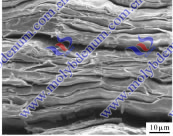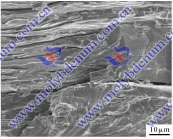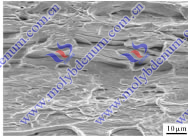
TZM alloy Neutron Radiation Handling As Follows:
Neutron radiation is to change the TZM alloy ductile - brittle transition temperature (DBTT) and mechanical properties of an important method.
TZM alloy by neutron radiation occurs after radiation hardened, brittle fracture is more sensitive, so that the ductility decreases. Through observation of the microstructure of the alloy, after neutron irradiation alloys found in the body after forming a large number of point defects (such as dislocations and pores ring), the point at which the material deformation defects arising from the intrinsic stress is greater than the material breaking stress .
TZM alloy on the process of neutron radiation, the radiation temperature is a very crucial factor, its tensile strength of the alloy DBTT and a great influence. BNSingh et al TZM alloy for neutron radiation study found, TZM alloy by neutron irradiation, tensile properties has been significantly improved, but the ductility decreased very large, but there is a certain increase in hardness, table TZM molybdenum alloy 294 ℃ the change in performance after neutron irradiation. Can be seen, the alloy by neutron radiation, at room temperature, the tensile strength test some increase, but the elongation is almost zero; when the test temperature is raised to 600 ℃, the tensile strength value is reached, but still no elongation alloy ; until the test temperature of 800 ℃, alloy only has a certain elongation (1.7%). After irradiation at 294 ℃, alloy body to form a large number of small pores and dislocation loops, are instantaneous movement of dislocation acts as a stable hindered, and thus the tensile strength ratio before radiation have been significantly improved, but also poor ductility of the alloy.
Table TZM molybdenum alloy tensile properties of the data before and after radiation
| Test temperature/℃ | Radiation condition | Tensile strength/MPa | Elongation/% |
| Room Temperature | No radiation | 815. | 5 16.4 |
| 294℃ radiation | 912.9 | 0.01 | |
| 600 | No radiation | 597.0 | 4.7 |
| 294℃ radiation | 1 166.6 | 0.01 | |
| 700 | No radiation | 572.0 | 4.5 |
| 294℃ radiation | 1 094.9 | 0.09 | |
| 800 | No radiation | 551.1 | 4.2 |
| 294℃ radiation | 920.5 | 1.7 |
The tensile properties of the data from the table, you can determine TZM molybdenum alloy at 294 ℃ DBTT after irradiation was 800 ℃, the microstructure observation confirmed the judgment.



Note: From left to right were: TZM alloy tensile fracture before radiation SEM photographs, TZM alloy irradiated at 600 ℃ SEM photographs of tensile fracture detection and TZM alloy irradiated at 800 ℃ SEM photographs of tensile fracture detection
As can be seen from the figure, after stretching at 600 ℃ sample, grain orientation very confusing, and stretched at 800 ℃ grain-oriented relatively consistent tension in favor of plastic deformation. BVCockeram et al [28] through the TZM molybdenum alloy 294 ~ 1 100 ℃ neutron radiation, and found that radiation at 300 ℃, alloy DBTT ago by radiation, the radiation increased to -50 ℃ after 800 ℃, while tensile strength increased a lot; radiation at 600 ℃, the tensile strength is also increased, but DBTT after irradiation was 700 ℃; when 935 ~ 1100 ℃ radiation, radiation hardened alloy occurs, DBTT after irradiation was -50 ℃ . TZM alloy about the study of neutron radiation, a common understanding of the radiation is at a lower temperature, the alloy body to form a large number of small pores, but when the radiation temperature higher (e.g., above 600 ℃), the alloy body is easy to produce some large pores, the alloy DBTT reduced.
If you have any interest in our TZM alloy(Titanium Zirconium Molybdenum) or other molybdenum alloy products, please feel free to contact us by email: sales@chinatungsten.com,sales@xiamentungsten.com or by telephone:86 592 512 9696.